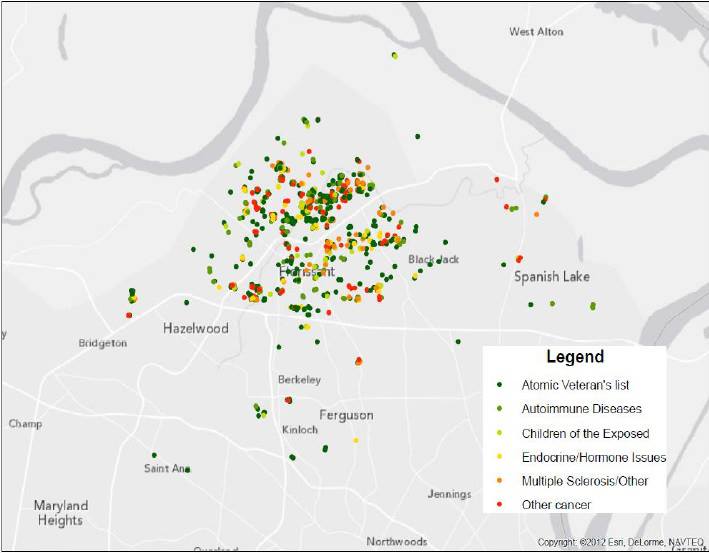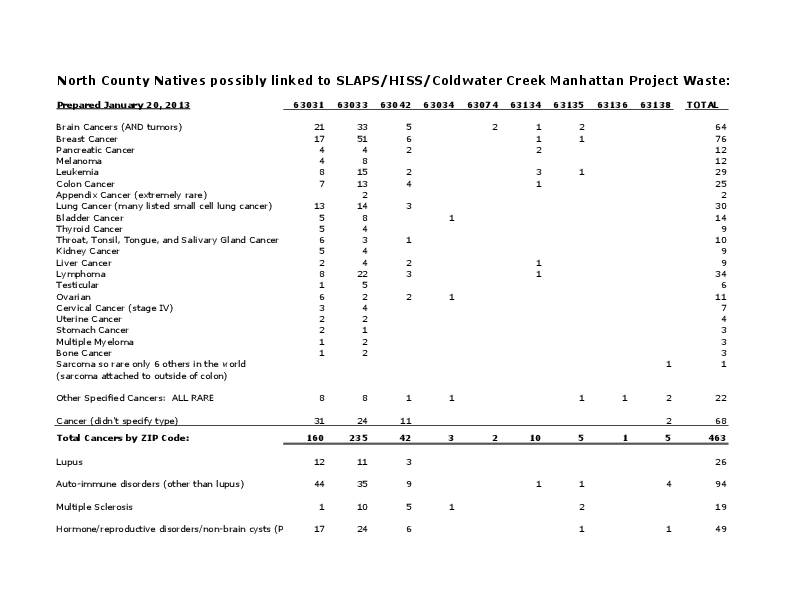
FROM KSDK.COM: Leisa Zigman’s I-team report.
ST. LOUIS COUNTY (KSDK) – There are radioactive secrets beneath the banks and waters of a north St. Louis County creek that may be linked to a staggering number of cancers, illnesses and birth defects. In four square miles, there are three reported cases of conjoined twins and cancer rates that one data expert says is statistically impossible.
About two years ago, Janell Wright and several of her class of ’88 McCluer North High School friends started wondering why so many of their peers were battling cancer.

“Where it got to be suspicious is when we had two friends diagnosed within a couple of months of each other with appendix cancer. And both people were told that is a one in a million cancer,” said Wright.
Wright, an accountant and former auditor, started collecting data from her classmates. Soon, peers from neighboring schools reached out too.
“On Facebook, it just took off like wildfire. People started reporting their cancers and auto immune diseases,” Wright said.
At first she found 30 cases. Within two months, she had data on 200 cases. Now, her maps have more than 700 cases in four square miles, including:
62 brain cancer cases
27 leukemia cases
26 lung cancer cases
24 multiple sclerosis cases
15 lymphoma cases
10 pancreatic cancer cases
3 conjoined twins
Wright became equally alarmed when data showed some of her classmates’ children had serious medical problems too.
“The children usually came down with brain cancer in the first 15 years of life, in addition, leukemia. In my peer group’s children, there were several children who had to have their thyroid removed before they were 10-years-old,” she said.

Strange coincidence or was something else at play? Another classmate, Diane Whitmore Schanzenbach, is an economist at Northwestern University. She ran her own analysis and found the likelihood of so many cancers among her high school peers was .00000001. Schanzenbach called it a statistical improbability.
Connected by Facebook, high school, and illness, the classmates made a startling discovery. The creek where they played as children carried a secret.
In the 1940s, Mallinckrodt Chemical Works in downtown St. Louis purified thousands of tons of uranium to make the first atomic bombs. But the process also generated enormous amounts of radioactive waste. Sighting national security, the government quietly ordered the material moved to north St. Louis County in 1947.
Twenty-one acres of airport land became a dumping site where a toxic mixture of uranium, thorium, and radium sat uncovered or in barrels. In the 1960s, government documents noted contents from the rusting barrels were seeping into nearby Coldwater Creek. And by the 1990s, the government confirmed unsafe levels of radioactive materials in the water.
“You’re having to grasp this idea that something was wrong. Nobody knew about it. Our parents didn’t know, nobody knew,” said Wright.
Wright and the 2,000 people now on the Facebook page Coldwater Creek Just the Facts Please wonder if they inhaled radioactive dust that blew in from the dump, or swallowed small amounts of toxic creek water.
Wright recently shared her data with the Army Corp of Engineers, which monitors the creek.
Members of the Facebook group want the CDC to investigate their data and determine if there is a cancer cluster. They are currently trying to build their case in hopes of getting to the truth.
Wright hopes she is wrong about the cancer cluster and link to Cold Water Creek. Her greatest fear is that she is right.
Based on the latest data, the Army Corp of Engineers reports there is no contamination threat to current homeowners. And monitoring of the creek continues.
Thirty people recently filed suit against Mallinckrodt and other companies. A spokesperson for Mallinckrodt, which is now owned by Covidian, said Mallinckrodt was not involved in the disposal or cleanup of the nuclear waste.
Lynn Phillips from Mallinckrodt’s Media Relations issued the following statement:”
“The St. Louis Airport Site was used for disposal of demolition debris from buildings decommissioned and demolished nearly 50 years ago by a third party demolition contractor under the oversight of the U.S. government. Some of this debris was from buildings formerly used for uranium processing dating back to the 1940s at a Mallinckrodt site in St. Louis. The U.S. Army Corps of Engineers in coordination with the Department of Energy is now responsible for the environmental remediation of the St. Louis Airport Site, which includes Coldwater Creek, under its Formerly Utilized Sites Remedial Action Program. This remediation is nearly complete. Mallinckrodt is not involved in the remediation activities that have been conducted at the St. Louis Airport Site. “
Click here to watch and read the second part of this investigation.
KSDK
